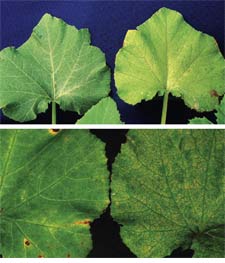 |
In a recent study the majority of 12 horticultural crop species exhibited clearly visible ozone injury symptoms. After a 2- to 3-week chronic exposure to ozone concentrations typical for Southern Germany (ca. 135 µg/m3, 8 hours/day), chlorotic discoloration frequently occured, often accompanied by small necrotic lesions. After an acute exposure, mimicking realistic ozone episodes in the same region (ca. 250 µg/m3, 4 hours/day), necrotic damage often became dramatic.
"External quality", i.e. the visible appearance of the produce, is crucial for the marketability of horticultural crops, including vegetables. This quality criterion, however, may be considerably affected by visible leaf injury due to the exposure to tropospheric ozone, as it regularly occurs in Central Europe during the growing season.
For vegetable growers it is important to know that this type of injury cannot be mitigated by common measures of plant protection. When an episode of high ozone is imminent, however, it might be advisable to avoid additional watering of the plants. During shortage of water, plants tend to keep closed their stomates, those little pores in the leaf surface that allow carbon monoxide (as well as air pollutants like ozone) to enter into the leaf. And less ozone uptake means less ozone damage. Therefore, well-timed cultivation measures can help to avoid leaf injury due to ozone at least temporarily.
These are results of a study undertaken jointly with the Federal Agriculture Research Center (FAL, Braunschweig), Institute of Agroecology, and funded by the Ministry of Economy, Transportation, Agriculture and Viticulture of Rheinland-Pfalz (Mainz).
|
 |

Chlorotic discoloration of the leaves (top row, right) and numerous small necroses, spread over the entire area of the leaf (bottom row, right), are typical ozone injury symptoms in zucchini (Cucurbita pepo L.). For comparison, undamaged leaves (not exposed to ozone) are shown on the left side.
|